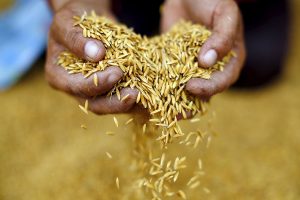THE Department of Agriculture (DA) said production in 2024 of palay, or unmilled rice, is estimated to be little changed at 20.1 million metric tons (MMT), due largely to the dry conditions brought on by El Niño.
“Because we were hit by El Niño and then in the second half by La Niña, we are hoping to achieve parity with last year,” Agriculture Secretary Francisco P. Tiu Laurel, Jr. said at a budget hearing in the House of Representatives.
The latest estimate represents a downgrade of an earlier DA projection of 20.44 MMT.
In 2023 palay production was 20.06 MMT, equivalent to about 13 MMT of milled rice.
“Our production fell during the first half. Then during the second half we are seeing wetter conditions, huwag lang sana tayo tamaan ng bagyo (We are hoping typhoons will not inflict serious damage), We’re hoping that our production will be the nearly the same as in 2023,” Mr. Laurel added.
In the first half, palay production dropped 5.5% to 8.53 MMT, according to the Philippine Statistics Authority. This was the lowest level of first half production since the 8.39 MMT posted in 2020.
“I don’t want to over-promise… but it would depend on the gravity (of La Niña),” Mr. Laurel said on the sidelines of the briefing.
The government weather service, known as PAGASA (Philippine Atmospheric, Geophysical and Astronomical Services Administration), declared the end of El Niño in early June.
“I’m expecting one or two strong typhoons… So I have to be more conservative in our estimates,” he added.
PAGASA estimated a 70% likelihood La Niña will set in between August and October, raising the probability of tropical cyclone activity in the coming months.
The rice harvest services about 70% of domestic demand, with imports taking care of the rest.
At the hearing, Mr. Laurel said that the DA estimates rice imports for 2024 of 4 MMT.
The US Department of Agriculture projects Philippine rice imports of 4.7 MMT this year, due to the higher-than-expected volumes during the first half.
“We are trying our best to increase production, not only (via) better seed and technology, but also with the increased number of harvests,” he added.
The government lowered the tariffs on imported rice to 15% from 35%, until 2028 through Executive Order No. 62, in a bid to bring down rice prices.
The DA has said that the lowered tariff on imported rice could bring down rice prices by P6-P7 per kilogram.
“With the 15% tariff… the price of rice should be at P45 per kilo by mid-October, couple with stable world market prices, and foreign exchange rates,” Mr. Laurel said.
He added that the DA is also proposing that the National Food Authority’s buying price for palay during the wet season harvest be set at P23 per kilo dry and P20 per kilo wet. — Adrian H. Halili
